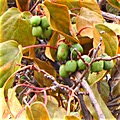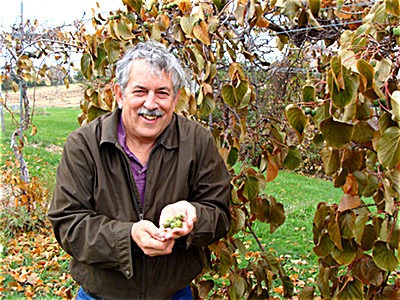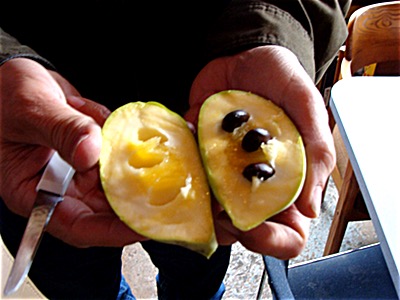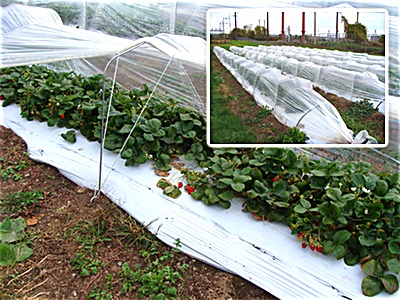- By Dan Veaner
- Around Town
 Print
Print  Kiwi fruit is delicious. The cute little round balls known as Hayward Kiwis are covered with fuzz. Cut into one and the green, fruity inside makes a perfect salad ingredient. In fact, the California Kiwifruit Web site lists 45 kiwi recipes for breakfast, lunch, dinner, salads, drinks and desserts. But did you know there are 194 other species of kiwi fruit? And that some of them are grown in Lansing? Only a few weeks ago Cornell Orchards harvested kiwi fruit on their Lansing farm -- various kinds without fuzz that you can eat right off the vine.
Kiwi fruit is delicious. The cute little round balls known as Hayward Kiwis are covered with fuzz. Cut into one and the green, fruity inside makes a perfect salad ingredient. In fact, the California Kiwifruit Web site lists 45 kiwi recipes for breakfast, lunch, dinner, salads, drinks and desserts. But did you know there are 194 other species of kiwi fruit? And that some of them are grown in Lansing? Only a few weeks ago Cornell Orchards harvested kiwi fruit on their Lansing farm -- various kinds without fuzz that you can eat right off the vine."There is interest in this kiwi fruit, for obvious reasons," says Dr. Marvin Pritts, a Professor of Horticulture at Cornell's Integrative Plant Science school. "It's the perfect American fruit, because you don't have to peel it. There are no seeds. You just pop it in your mouth and eat it. It's unusual. It tastes good. if you pick it before the frost it stores for a fairly long time. You can bring it out, even when it's hard, and let it sit out for a day or two to get soft and ripen. The fuzzy Hayward species you find in stores is a tropical fruit, and won't grow this far north. But many of the other species do grow in our climate. The different varieties have different colored flesh, and shapes."
Cornell Orchards maintains two farms in Tompkins County -- in Ithaca and Lansing -- specifically for growing fruit. The Ithaca orchard is used for teaching because it is convenient for students to come across the road from the campus. But some fruits will only grow at the warmer Lansing farm, so classes occasionally meet there as well. The Lansing orchard is used to grow cherries, peaches, apples, blackberries, kiwis, paw paws and chestnuts that require a slightly warmer climate.
 Cornell Horticulture Professor Marvin Pritts plucking kiwi fruit off a vine at Cornell Orchards
Cornell Horticulture Professor Marvin Pritts plucking kiwi fruit off a vine at Cornell OrchardsAnd paw paws. Paw paws are native to North America. Many tropical southern fruits are related to the paw paw. Pritts says paw paws are grown on the Lansing farm because it is close to the lake, which provides a warmer climate for the fruit, as it does for grape orchards all over the Finger Lakes. Kiwis need at least one male plant to cross pollinate the female plants. The fruit grows on the females.
 Paw paws look like deformed pears on the outside, but the inside has a banana-like texture that tastes like a pear and a melon have been blended to yield a quite refreshing and delicious fruit
Paw paws look like deformed pears on the outside, but the inside has a banana-like texture that tastes like a pear and a melon have been blended to yield a quite refreshing and delicious fruitIt is, indeed. If a pear were a melon, that's what the paw paw tastes like. It has that very refreshing quality of a watermelon, but with a very different taste.
Three kiwi varieties at the Ithaca orchard grow on arbors similar to those used for growing grapes. These kiwis look like large malformed elongated grapes. One tastes a lot like the Hayward Kiwi, while another has a more perfumy taste. Another has a more subtle taste. The inside of all three looks like the more familiar kiwi fruits, but these kiwis can be eaten off the vine without peeling them first.
Kiwi fruit is native to China, though today they are grown around the world in countries like China, India and the United States. When it were first grown in this country it was known as Chinese gooseberry.
"Nobody was interested in buying it," Pritts says. "A marketing outfit got some plants from New Zealand, because they were growing in China and other parts of that South Pacific area. They decided to call them kiwi fruit, because it looks like a little kiwi bird from New Zealand. They changed the name, and all of a sudden sales went through the roof. It was the same plant -- it was all in the name -- even though they're not native to New Zealand."
In addition to the Ithaca and Lansing orchards, Cornell Orchards maintain a research farm at the Geneva Experiment station, and fruit farms along Lake Erie, the Hudson Valley, and Long Island. The kinds of crops are chosen based on course material, for research, or to demonstrate new technologies, such as a new trellising technique, or varieties to commercial growers.
 Experimental tunnels greatly extend the strawberrie season
Experimental tunnels greatly extend the strawberrie seasonOne example is the rows of strawberries that are grown in low, plastic tunnels. A variety that is not sensitive to daylight is being grown in the tunnels, so they flower and produce fruit under all daylight conditions, rather than only producing on short days, as typical strawberries do. The tunnels exclude infrared radiation, so the strawberries are kept cooler in the summer, and warmer in the fall, which greatly extends the growing season.
The harvesters are paid professionals, some of them migrant workers, others Ithaca residents who make themselves available at harvest time. They work from August through October eight hours a day, typically harvesting in Lansing one or two days a week, and in Ithaca the rest of the time. The kiwis and paw paws were harvested in Lansing a couple of weeks ago.
 The Lansing farm benefits from warmer temperatures along Cayuga Lake in the same way that local grape orchards do
The Lansing farm benefits from warmer temperatures along Cayuga Lake in the same way that local grape orchards do"It might take 30 years to develop a new apple variety or strawberry variety," he says. "It takes a long time to make the cross, to draw out the seed, and you only one have one plant. You have to test it and if it looks good, make more of it, trial it, and when it comes here for more testing it's very expensive. Each row of these strawberries costs about $250. We get two pounds of fruit per foot of a row. These rows are 60 feet long. that's 120 pounds, and we're selling it for $4 per pound. We get $480 for this fruit, and then we have to subtract the cost of these tunnels, which is $250. And the labor, the fertilizer and pay to have them picked. We sell things but we don't really make money. We kind of break even, at best."
Whatever the reason, the store gives local residents the chance to stock up on the fall crop. Apples, berries, grapes... and kiwis and paw paws.
v11i42



